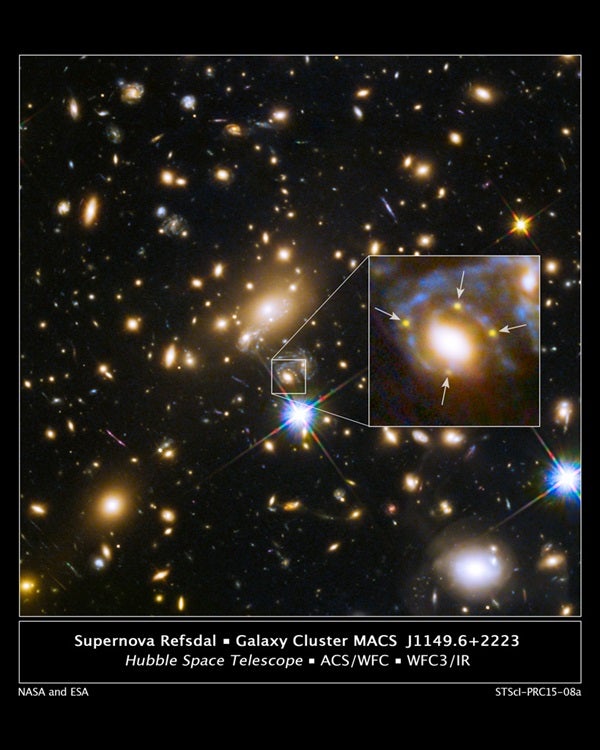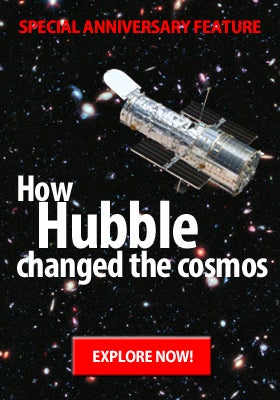This unique observation will help astronomers refine their estimates of the amount and distribution of dark matter in the lensing galaxy and cluster. Dark matter cannot be seen directly but is believed to make up most of the universe’s mass.
The gravity from both the elliptical galaxy and the galaxy cluster distorts and magnifies the light from the supernova behind them, an effect called gravitational lensing. First predicted by Albert Einstein, this effect is similar to a glass lens bending light to magnify and distort the image of an object behind it. The multiple images are arranged around the elliptical galaxy in a cross-shaped pattern called an Einstein Cross, a name originally given to a particular multiply imaged quasar, the bright core of an active galaxy.
The elliptical galaxy and its cluster, MACS J1149.6+2223, are 5 billion light-years from Earth. The supernova behind it is 9.3 billion light-years away.
When the four images fade away, astronomers predict they will have a rare opportunity to catch a rerun of the supernova. This is because the current four-image pattern is only one part of the lensing display. The supernova may have appeared as a single image some 20 years ago elsewhere in the cluster field, and it is expected to reappear once more within the next five years.
This prediction is based on computer models of the cluster, which describe the various paths the supernova light is taking through the maze of clumpy dark matter in the galactic grouping. Each image takes a different route through the cluster and arrives at a different time, due, in part, to differences in the length of the pathways the light follows to reach Earth. The four supernova images captured by Hubble, for example, appeared within a few days or weeks of each other.
The supernova’s various light paths are analogous to several trains that leave a station at the same time, all traveling at the same speed and bound for the same location. Each train, however, takes a different route, and the distance for each route is not the same. Some trains travel over hills. Others go through valleys, and still others chug around mountains. Because the trains travel over different track lengths across different terrain, they do not arrive at their destination at the same time. Similarly, the supernova images do not appear at the same time because some of the light is delayed by traveling around bends created by the gravity of dense dark matter in the intervening galaxy cluster.
“Our model for the dark matter in the cluster gives us the prediction of when the next image will appear because it tells us how long each train track is, which correlates with time,” said Steve Rodney of the Johns Hopkins University in Baltimore, Maryland. “We already missed one that we think appeared about 20 years ago, and we found these four images after they had already appeared. The prediction of this future image is the one that is most exciting because we might be able to catch it. We hope to come back to this field with Hubble, and we’ll keep looking to see when that expected next image appears.”
Measuring the time delays between images offers clues to the type of warped-space terrain the supernova’s light had to cover and will help the astronomers fine-tune the models that map out the cluster’s mass. “We will measure the time delays, and we’ll go back to the models and compare them to the model predictions of the light paths,” Kelly said. “The lens modelers, such as Adi Zitrin from the California Institute of Technology, will then be able to adjust their models to more accurately re-create the landscape of dark matter, which dictates the light travel time.”
While making a routine search of the GLASS team’s data, Kelly spotted the four images of the exploding star November 11, 2014. The FrontierSN and GLASS teams have been searching for such highly magnified explosions since 2013, and this object is their most spectacular discovery. The supernova appears about 20 times brighter than its natural brightness due to the combined effects of two overlapping lenses. The dominant lensing effect is from the massive galaxy cluster, which focuses the supernova light along at least three separate paths. A secondary lensing effect occurs when one of those light paths happens to be precisely aligned with a specific elliptical galaxy within the cluster. “The dark matter of that individual galaxy then bends and refocuses the light into four more paths,” Rodney explained, “generating the rare Einstein Cross pattern we are currently observing.”
The two teams spent a week analyzing the object’s light, confirming it was the signature of a supernova. They then turned to the W. M. Keck Observatory on Mauna Kea, in Hawaii, to measure the distance to the supernova’s host galaxy.
The astronomers nicknamed the supernova Refsdal in honor of Norwegian astronomer Sjur Refsdal, who, in 1964, first proposed using time-delayed images from a lensed supernova to study the expansion of the universe. “Astronomers have been looking to find one ever since,” said Tommaso Treu of the University of California, Los Angeles, the GLASS project’s principal investigator. “The long wait is over!”
The Frontier Fields survey is a three-year program that uses Hubble and the gravitational-lensing effects of six massive galaxy clusters to probe not only what is inside the clusters but also what is beyond them. The three-year FrontierSN program studies supernovae that appear in and around the galaxy clusters of the Frontier Fields and GLASS surveys. The GLASS survey is using Hubble’s spectroscopic capabilities to study remote galaxies through the cosmic telescopes of 10 massive galaxy clusters, including the six in the Frontier Fields.











